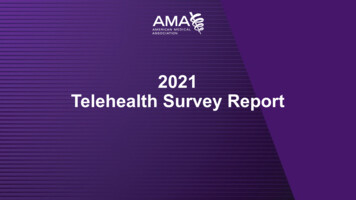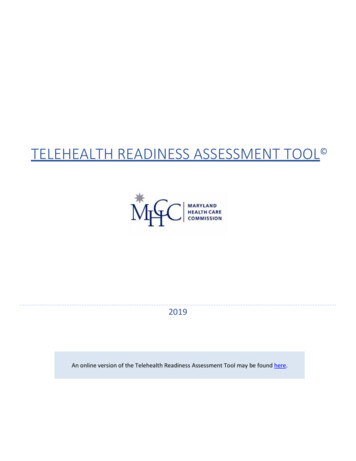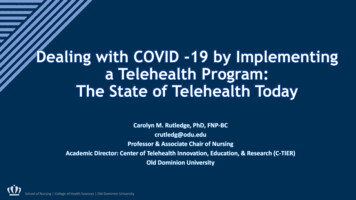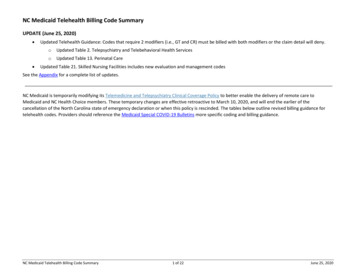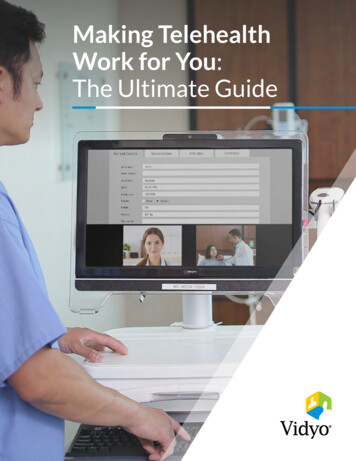
Transcription
Making TelehealthWork for You:The Ultimate Guide
Making Telehealth Work for You: The Ultimate GuideFor those considering a virtual health program, or thinking about adding to their existing one, thefollowing guide is a comprehensive overview of how to get buy-in and support for a virtual healthstrategy.“We started out with those brick-like cell phones, but stillhad to carry around a bulky pager. It seemed like everystep toward getting better-connected to our patientsrequired a few steps back. Thankfully, that’s not truetoday. Telehealth keeps us in touch with, and extendsour care to, patients in a convenient, timely, and mostimportant — effective — way.”These reflections from a pediatrician at a large practice are becoming more common in anindustry that historically lags behind other markets in technology adoption. It is a positiveindication of what lies ahead as healthcare gets more comfortable with using telehealth toadvance patient outcomes.According to a recent telehealth adoption study commissioned by Vidyo, Inc.,over 75% of nurses, physicians, healthcare administrators, and healthIT professionals are currently using, or plan to use telehealth solutions.That’s encouraging, given the advantages that live video, remotepatient monitoring, and mobile health offer to bothpatients and providers.2 Vidyo, Inc.
Making Telehealth Work for You: The Ultimate GuideFIGURE 1: VIRTUAL HEALTH ADOPTION IS ACCELERATINGPercentage of providers using virtual health in their organization or practice80%70%60%Virtual Health adoption has grownby 33% over the period shown;however many are still reluctant 6Source: HIMSS Analytics as Reported by MHealth IntelligenceAdditional data from HIMSS Analytics shows that telemedicine use by providers has risen to72%, having jumped from 54% in 2014. After consistently growing 3.5% annually, adoptionhas increased by roughly 9% since 2016.A study by global consulting firm Accenture found that virtual health could generate 10 billion in economic value annually across the U.S. health system, and experts pointto virtual health as one of the most efficient and effective means of confrontingsocial determinants of health obstacles because it breaks down barriers toaccessing physical care.Still, many stakeholders are reluctant to go too far down the virtual healthpath. Some cite cost or low demand as reasons. Others are uncertainabout the regulatory and compliance environment for telehealth.But just as the stethoscope was initially greeted with someskepticism for its effectiveness as a diagnostic tool — only to beuniversally adopted and still in use 200 years later — virtualhealth is a solution whose time has come.3 Vidyo, Inc.
Making Telehealth Work for You: The Ultimate GuideVirtual Health and TelehealthWhile commonly referred to as telehealth,a better term is virtual health because it ismore descriptive. The prefix tele- impliessomething coming from a distance, whenin fact the technology behind this termactually brings patient and provider closertogether. Commenting on how virtual healthis becoming a standard of care, MichaelHaschker, Manager, Network Systems andTelehealth Technologies of the MedicalUniversity of South Carolina, says, “I seethe ‘tele’ being removed from telemedicineand telemedicine as we know it today.(it is becoming) a part of the integratedhealthcare system and health plans for people.”Virtual Health Could Generate 10 Billionin economic value anually acrossthe U.S. Health SystemVirtual health, as defined by Harvard Business Review, is the use of “enabling technology to deliverhealth services in a way that is independent of time or location.” Through video visits, virtual rounds, andvideo responses to nurse calls, or by bringing specialist expertise to wherever it’s needed, virtual healthis personalized healthcare without borders.“I see the 'tele' being removed from telemedicine andtelemedicine as we know it today. . .(it is becoming) a part ofthe integrated healthcare system and health plans for people.”-Michael Haschker,Manager, Network Systems and Telehealth Technologies ofthe Medical University of South Carolina4 Vidyo, Inc.
Making Telehealth Work for You: The Ultimate GuideWhat Seems to Be the Problem?Just as a physician begins every consult with open-ended questions to discern the reason for a patient’svisit, the road to a virtual health strategy begins with a purposeful look at the benefits of adding orexpanding virtual health in an organization. Does the physician practice want to treat more patients? Isthe clinic trying to save money and improve access to care? It’s important to assess the challenges facedby the physician or health system to determine how virtual health would be beneficial.To recruit other hospitals and health systems to join the Center for Telehealth at Dartmouth-HitchcockMedical Center, Dr. Sara Pletcher listened carefully to the problems each organization was facing beforeadvancing a particular solution. Not surprisingly, there was a lot of variation. From increasing regionalmarket share to delivering on a set of patient-centered care metrics, virtual health adoption began witha strategic look at the problems it might be able to solve, followed by working to customize a successfulsolution.5 Vidyo, Inc.
Making Telehealth Work for You: The Ultimate GuideWhat’s Getting in the Way of Realizing a Solution?Despite an awareness of the specific benefits virtual health can provide, the most enthusiastic virtualhealth adopter can be stymied by a number of barriers. According to the Vidyo study (see graphic on thefollowing page), the primary reasons why providers are wary of adopting virtual health are: Not enough demand to justify the expense Cost of implementation and complexity Lack of state or national policies and reimbursement Concerns about privacy and HIPAA compliance Lack of clinical staffing Infrastructure issues Integrations with electronic health records (EHR)6 Vidyo, Inc.
Making Telehealth Work for You: The Ultimate GuideCommon Barriers to Live Video AdoptionFIGURE 2: NON-ADOPTERS CITE DEMAND AND COSTS AS PRIMARY BARRIERSWhy do you not intend to adopt live video?N 46Not enough demand to justify expenseCost of implementationDisadvantages compared to face-to-face encountersComplex Reimbursement rules and regulationsComplexity of implementationConcerns about privacy/HIPAALack of infrastuructureLack of supportive state or national policyLack of data to support ROI/outcomesIntegration issues with EHR0%10%20%30%40%50%FIGURE 3: FENCE SITTERS CITE PRIVACY AND LACK OF DEMAND AS PRIMARY BARRIERSWhy are you unsure about adopting live video?N 33Concerns about privacy/HIPAANot enough demand to justify expenseCost of implementationComplexity of implementationDisadvantages compared to face-to-face encountersLack of infrastructureIntegration issues with EHRLack of supportive state or national policyLack of data to support ROI/outcomesComplex reimbursement rules and regulations0%Source: 2018 Vidyo Telehealth Adoption Study7 Vidyo, Inc.10%20%30%40%50%
Making Telehealth Work for You: The Ultimate GuideCommon Barriers to Real-Time Video Adoption (cont'd)Perceived lack of demandWithout provider/clinician support, patient interest, or local market competition, demand for virtualhealth will seem low or nonexistent. In each of these instances, providers may be unclear about whatexactly virtual health is and how it can help them simplify as well as expand their practice. In addition,providers often assume that patients prefer face-to-face treatment, when in fact many patients preferthe convenience and personal attention of a virtual visit. According to longtime telehealth advocate,Lauren Faison, from Tallahassee Memorial Healthcare: "Virtual care is here to stay. It’s not a fad. It isbecoming much more commonplace and people will expect it from their physicians.”Just as explaining the benefits of a particular drug or therapy to a patient is good medicine, clearlycommunicating the how and why of a virtual health program — to physicians and clinicians as well as topatients — is critical to getting stakeholders to truly understand the demand level for virtual health.It’s important to identify clinical champions in every use case, such as a physician on the providerside and a nurse/practice manager on the patient side who can advance understanding andbuy-in for the rest of the team.“Virtual care is here to stay. It's not a fad. It isbecoming much more commonplace and peoplewill expect it from their physicians.”-Lauren Faison, Tallahassee Memorial Healthcare8 Vidyo, Inc.
Making Telehealth Work for You: The Ultimate GuideCommon Barriers to Real-Time Video Adoption (cont'd)Cost and complexity of implementationPoor experiences with EHR implementations that were expensive, complicated and took a great dealof time and IT resources have created lasting hesitancy for many in healthcare. It’s a rational fear forhospital systems overburdened with system implementation and update demands — just look at therecent earnings from Vanderbilt University Medical Center. The 3 billion medical system ended thefirst nine months of fiscal year 2018 with operating income of 44.4 million, down 60% from 110million in 2017. Vanderbilt attributes the bulk of the income loss to the cost of implementing a new EHRsystem.While the Vanderbilt experience may be typical of EHR implementations, virtual health implementationis far less difficult because it can — and should — be done in a customized manner. Cloud-basedvirtual health platforms use fewer internal resources because they don’t require hardware andsoftware management. For those reluctant to fully embrace moving to the cloud, hybrid models can beconstructed that allow local traffic to stay local while also taking advantage of the convenience ofcloud-based connectivity and management.9 Vidyo, Inc.
Making Telehealth Work for You: The Ultimate GuideCommon Barriers to Real-Time Video Adoption (cont'd)Lack of state or national policies and reimbursementA recent Advisory Board update points to perhaps the biggest barrier to virtual health adoption: howproviders will be paid. Recent legislation indicates that more favorable virtual health reimbursementmodels are emerging to swiftly lower this obstacle. Until recently, the Center for Medicare andMedicaid Services (CMS) reimbursed only for live audio-visual virtual health visits in rural areas. Despitethese reimbursement barriers, Medicare volumes continue to grow. Early in 2018, CMS added remotemonitoring services to the mix. Virtual health is now also a basic benefit of Medicare Advantage, ratherthan an optional add-on -- all of these adjustments should fuel further Medicare telehealth volumes.FIGURE 4: MEDICARE FEE FOR SERVICE CLAIM VOLUMES CONTINUE TO GROWMedicare policy changes are driving growth250,000200,000As CMS continues to expandtelehealth coverage, we expectvolumes will continue to Source: 2018 Advisory Board Telehealth Trends PresentationOn the commercial side, according to the Advisory Board, “There's been a recent uptick in commercialparity legislation, which requires health plans to cover virtual services the same way they would coverin-person services. As of January 2018, 36 states and the District of Columbia have one of these laws inplace — an increase of four states over the last year.” To stay abreast of state-by-state changes in virtualhealth reimbursement, the Center for Connected Health Policy website or the Advisory Board Primerare valuable resources.10 Vidyo, Inc.
Making Telehealth Work for You: The Ultimate GuideCommon Barriers to Real-Time Video Adoption (cont'd)Concerns about privacy and HIPAA complianceNow that healthcare has earned the dubious distinction of beingthe industry most vulnerable to data breaches, it’s understandablethat hospitals and health systems have a number of data privacy andHIPAA compliance concerns with virtual health. According to theHIMSS Analytics study, it’s an especially “great hurdle” for outpatientservices. For those using virtual health for behavioral healthpurposes, there’s the added concern that household members couldoverhear private conversations between provider and patient.To alleviate data privacy concerns, providers should be careful aboutthe kind of virtual health solution in use. Asynchronous or storeand-forward telemedicine platforms are now showing up in primarycare programs. Proponents say it gives them a better chance touse evidence-based care delivery practices at lower risk. However,video-exclusive platforms are generally more secure because theydon’t store patient health information. Behavioral health uses can beimproved by obtaining patient consent to have family participate.No matter what the use case is, virtual consent forms should be inplace between patient and provider, and any virtual health solutionshould include a business associate agreement (BAA) to ensure bothcontractual and regulatory compliance between vendor and provider.11 Vidyo, Inc.
Making Telehealth Work for You: The Ultimate GuideCommon Barriers to Real-Time VideoAdoption (cont'd)Infrastructure issuesLack of clinical staff, integrations with EHR, and other infrastructureissues are important considerations for every health organizationconsidering virtual health. Those who have successfully addressedthem point to several factors for smooth adoption and integration: Start small, perhaps a pilot project with existing clinical staff,then work toward integration into workflows so virtual healthbecomes, as some say, “just part of how our clinic works.” Lateriterations might include a dedicated virtual health staff, but it’simportant to start small and move deliberately toward adoption. Technology, as always, is advancing. Many elements of virtualhealth are available via smartphone or tablet, making it availableeven for remote treatment. Video can now be delivered withminimally required packets and can adjust to any bandwidth, soany network concerns with additional bandwidth can be readilyaddressed. If additional technology infrastructure is required, federal grantfunding may be an option for eligible recipients. EHR integration, surprisingly, is not so significant a considerationas some might assume. Most who have gone through a virtualhealth integration find it can be done fairly easily, and instead citeintegration into clinical workflows as the real hurdle. Vendorswith interoperable solutions and a proven track record ofsuccessful integrations are preferable to those with off-the-shelfsolutions that flow parallel to the current EHR.12 Vidyo, Inc.
Making Telehealth Work for You: The Ultimate GuideRemember: Not Everyone Likes Thin MintsWith barriers reviewed and a list of desired benefits in hand, it’s time to get to work on animplementation strategy. Most hospitals and health systems will quickly discover that virtual health isnot a one-size-fits-all solution.As Dartmouth-Hitchcock’s Pletcher says, “Everyone has a favorite cookie. You can’t tell a Thin Mintguy all about the merits of a Tagalong and expect him to write something down on the order form.” TheHIMSS Analytics study echoes the need for customization: “A telemedicineplatform or use case is not universally valuable to all healthcare orgs/facilities.”Working through the specific virtual health benefits to your organization and openlydiscussing the hurdles to adoption are vital for successful adoption.13 Vidyo, Inc.
Making Telehealth Work for You: The Ultimate GuidePlan Your Work and Work Your Plan. Repeat Often.With strategy in hand, it’s time to execute. As with the adoption of any new technology, it’s not going to besmooth sailing. It’s wise to prepare in advance for the inevitable upgrades and software tweaks.To measure performance and return on investment (ROI), make sure you have the right accountabilityprocedures in place and work with your vendor to provide best practice recommendations on keyperformance indicator (KPI) dashboards . In addition to clinical measurements, patient feedbackmechanisms and a formal patient communications strategy are vital KPIs to maintain.If you’re unsure if the ROI estimates are a stretch but achievable, there are tools in the market to developspecific ROI, as well as third-party data for additional validation such as the analytics offered by IgnisHealth and other HIT vendors.Virtual health holds great promise for addressing a number of gaps in our health system, from the chronicshortage of primary care doctors to care for vulnerable populations in remote, hard-to-reach areas. Justas René Laënnec’s stethoscope revolutionized the practice of medicine, virtual health will transform thehealthcare landscape for years to come.Resources Center for Connected Health Policy at The National Telehealth Policy Resource Center Telehealth Resource Center American Telemedicine Association Vidyo Advisory BoardVidyo, Inc. (Corporate Headquarters)433 Hackensack Ave., Hackensack, NJ 07601, USATel: 201.289.8597 Toll-free: 866.998.4396Email: .comapac@vidyo.comindia@vidyo.com 33 (0) 488 718 823 852 3478 3870 91 124 4111671INDIA Vidyo, Inc. All rights reserved. Vidyo and other trademarks used herein are trademarks or registered trademarks of Vidyo, Inc. or their respectiveowners. All specifications subject to change without notice, system specifics may vary. Vidyo products are covered by one or more issued and/orpending US or foreign patents or patent applications. Visit www.vidyo.com/patent-notices for information.
According to a recent telehealth adoption study commissioned by Vidyo, Inc., over 75% of nurses, physicians, healthcare administrators, and health IT professionals are currently using, or plan to use telehealth solutions. That's encouraging, given the advantages that live video, remote patient monitoring, and mobile health offer to both

